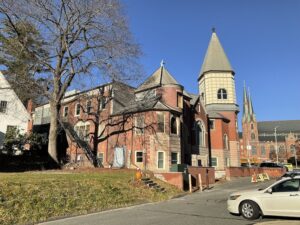Who is a member?
Our members are the local governments of Massachusetts and their elected and appointed leadership.

Northampton is working to convert a long-shuttered downtown church into a community resilience hub. A local agency, Community Action Pioneer Valley, will manage the resilience hub. (Photo courtesy Jones Whitsett Architects/Berkshire Design Group)
As Northampton confronts homelessness and the effects of climate change, the city is converting a long-shuttered church into a “community resilience hub” to address weather-related challenges and economic inequality.
The city paid $3.2 million for the former First Baptist Church on Main Street last year, with renovation plans for a daytime center serving homeless residents, community meeting space, emergency shelter capacity, and centralized community services. City officials this spring have been holding a series of public forums to update residents about the project and get feedback.
The resilience hub grew out of a desire to maintain inclusivity — meeting the needs of the city’s homeless residents and respecting their right to be downtown, while addressing the safety concerns of downtown businesses and their customers, said Mayor Gina-Louise Sciarra.
“This has been a conversation that Northampton has had for many years,” she said. “We have a very vibrant downtown. We have a downtown that really respects that everybody is a part of our community, and we have a strong history and culture of public space. … But there was still an interest in — how can we work together in the community to address some of these issues?”
The answer came in the form of a downtown church that had been closed since 1993. The previous owner had been renovating the 14,500-square-foot building for a wedding and entertainment venue, but those plans didn’t work out. When officials finally got inside the building, Sciarra said, they saw extensive upgrades, including the setup for a commercial kitchen, plumbing, and an elevator shaft.
“It was a remarkable moment to walk in and see what had been hidden for years,” Sciarra said.
Given the building’s proximity to downtown businesses, the library and Smith College, officials said, the location is highly visible and accessible. It also helped that the church had little appeal to other potential buyers. As Northampton recovered economically from the pandemic, the city didn’t want to displace potential businesses from prime real estate, said Carolyn Misch, the city’s planning and sustainability director.
“There are not a lot of people looking for old churches to do their next big thing,” Misch said. “We knew that if the city didn’t take this property, it could sit vacant for another 30 years for someone to come along.”
On the building’s first floor, the hub’s commercial kitchen will serve meals, and people will have access to wifi, showers, laundry, places to rest, and centralized social services. The city will use the second floor for emergency shelter during climate emergencies, and for vaccine clinics, performances, art exhibits, public meetings and other community gatherings. The third floor will house the Division of Community Care, which provides an unarmed public safety response to people in crisis.
Northampton is exploring geothermal technology for both the resilience hub and the nearby library. The project will also tie into a larger redesign of Main Street to make it more walkable and safer for pedestrians and bicyclists, Sciarra said. That work is expected to begin in fall 2025.
The city hopes to complete renovations by late 2025, depending on finances. Northampton is exploring grant opportunities, and the project is also seeking donations. The city already used American Rescue Plan Act funds toward the building purchase.
Sciarra said she hopes that the new hub will help promote community interconnectedness.
“It’s not a segregated, separate space,” Sciarra said. “This is going to be a community space that everyone uses, and everyone who uses this building is a part of this community.”